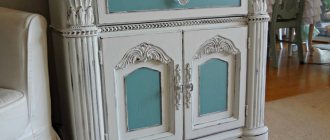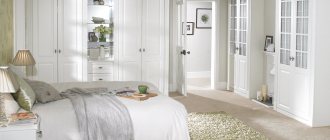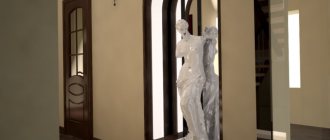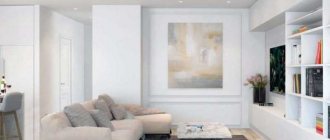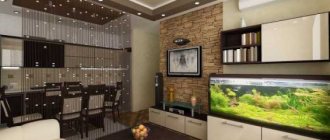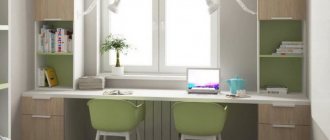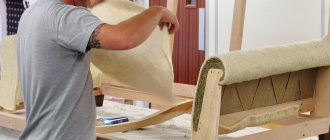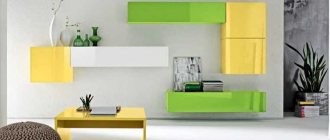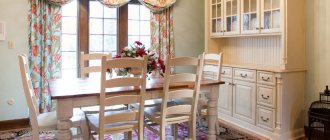Sideboard and its place in our home
Sideboards first appeared in France in the 18th century. Only rich citizens could have them, since beautiful dishes in themselves were a luxury item. Accordingly, sideboards made of valuable wood were also available to a select few.
Antique sideboards
Ancient sideboards, like modern ones, consisted of two parts:
- the top one, in which there are shelves behind glass doors;
- the lower one is closed, with shelves behind doors or drawers.
Important! Sideboards quickly gained popularity. Having such a cabinet in the living room, containing exquisite dishes and crystal, was simply necessary to emphasize one’s status and boast of wealth. They were decorated with carvings, gilding, shaped forged handles, bent legs and elegantly decorated doors. They were made by hand, so they were all unique.
USSR cabinets
After a couple of centuries, a cupboard became a mandatory attribute of any European home. During the Soviet Union, this piece of furniture was in every apartment, but the appearance, of course, was not as pompous as its “brother” from the 18th century. It was rustic, laconic, one might say, minimalistic in design.
Such sideboards were produced by factories in huge quantities, but in appearance they all looked alike, like soldiers in the ranks. As we remember, mass production was inherent in everything - from clothing to dishes and vases. The interior of the apartments of average citizens was similar to each other.
A couple of decades ago, everyone was tired of sideboards, and it became unfashionable to have them in the apartment. But a little time passed and they were remembered again.
Our days
Now every self-respecting furniture manufacturer must have sideboards in their collection: simple and elaborate, wooden and plastic, standard and corner. Designers love this piece of furniture; it can be matched to any style of room. Moreover, modern cupboards are equipped with mirrored walls, lighting, and original fittings.
But in order for all this sophistication and originality to be appreciated, you need to know how to beautifully arrange dishes in a sideboard in the living room.
Important! For those who do not like the standard form of a sideboard, they produce ones that have a niche for a TV. The so-called “slides” for the hall are also sideboards in their own way, because in addition to shelves and a cabinet for TV and other equipment, there are display racks on the sides for dishes or books.
What is
A showcase cabinet is a fully or partially glazed structure that is used for open storage of dishes and other decorative elements. They are very similar to display cases in stores, but the difference between store designs is that they are used to openly display goods to the buyer. But in the living room this furniture is installed in order to show relatives and friends beautiful and entertaining things.
Showcase cabinets are necessary not so that the owners can boast of expensive things, luxurious dishes, beautiful objects, but so that guests can become interested in the furnishings in the living room and see its sights.
Important features of the display cabinet:
- designs of this type usually have transparent doors, behind which you can clearly see various beautiful things, dishes, and decorative elements;
- Inside the cabinet there are glass or mirror shelves that are designed to accommodate small items. For this reason, there is no need to overload them with massive things, books;
- inside the back wall usually has a mirror surface, which makes the cabinet wide and voluminous;
- internal glass can have various patterns, carved designs that will add sophistication to the furniture;
- external glass doors always protect dishes, figurines, sets from dust and dirt. All items that will be stored in this design will always look bright and beautiful.
It is quite rare to find a display cabinet on sale, but despite this, this furniture continues to be in demand. And this is not in vain, because how beautiful it is when the living room has a bright corner in which you can put any objects, figurines, beautiful tableware or expensive crystal wine glasses.
What to fill the sideboard with?
What to put in the sideboard under glass instead of dishes? Each housewife has accumulated a considerable amount of sets, glasses, glasses and cups. And for myself, and for the dowry, and what was inherited from my beloved grandmother.
Everything seems beautiful, but is it necessary to display all the dishes in the sideboard?
- It is better not to display ceramic dishes and pottery. Find a place for them on open shelves in the kitchen if it is in Country or Provence style. And then, in small quantities. Better to stack them in a closed bottom section.
- A porcelain service, especially if it is rare or expensive, for example, Meissen, has the right to be located in a sideboard. But not in full force. A beautiful tureen, gravy boat, or salad bowl is enough. It is also better to place a pyramid of numerous plates downwards. You can place the largest dish vertically under the far wall.
- Tea sets are also not displayed in full. The teapot, sugar bowl, and milk jug are worthy of attention; you can supplement this group with a couple of cups and saucers. But such a service, of course, must be original and beautiful.
Important! Such compositions harmonize well with small trinkets: a napkin holder, small porcelain figurines, beautiful candles, tiny ceramic vases.
- Crystal will take its rightful place in the sideboard: glasses and glasses of different shapes and sizes. But they should stand separately from porcelain and ceramics. The crystal will play beautifully with all its faces if it is placed on a backlit shelf.
Important! Sometimes elite drinks or just drinks in unusual bottles are placed in the sideboard.
- What is undesirable to place in a sideboard are “towers” of heavy plates, bulky vases, photographs of numerous relatives, feathers, shells, mummified sea urchins and other souvenirs brought from resorts in memory of a vacation. Rows of identical glass glasses will also look ugly - it is better to hide them down, out of sight.
What we will eat: cutlery
Cutlery plays an important role. The number of spoons (table and tea spoons), forks, and knives should exceed the number of people in the family. Cutlery is more likely to fall between tables and get lost in cabinets.
In addition to table knives, the following cutting utensils are needed for food:
- large sharp meat knife (blade length 18-20 cm);
- medium knife for large vegetables (blade about 10 cm), if the family is large and several people are engaged in cooking, then you need more such knives - two or three;
- a small knife for peeling fruits and removing eyes from potatoes (blade 6 cm);
- a special cutting device for quickly peeling vegetables;
- a serrated knife for bread and tomatoes;
- a knife or grater for cutting vegetables into shapes (long Korean carrots or thin shredding cabbage);
- scissors for trimming fish fins;
- knife sharpener.
How to properly place dishes in a sideboard?
Stylish arrangement of dishes in a sideboard, how to do it? There are several rules that will help you create a beautiful composition of dishes, and not assorted chaos. There may be many original items, but not all of them fit together. So, what rules should you follow when you decide how to beautifully arrange dishes in a sideboard?
Rule #1. Single style:
- Don't display everything you have in your bins. From the available sets and services, select those that most harmoniously combine not only with each other, but also with the color scheme of the room.
- Sets and services standing next to each other must be combined in functionality and the material from which they are made. Do not place crystal glasses next to the coffee set.
- Do not place figurines, vases and other small items next to crystal - place them only near ceramics and porcelain.
Rule #2. Observe the measure:
- You shouldn’t display everything from the services. Choose the most successful things: a salad bowl, a teapot, a milk jug, a fish dish, a couple of cups and saucers, and leave the stacks of plates at the bottom.
- Arrange items so that there is space between them and each item can be looked at.
- Place family heirlooms and items that are especially valuable to you in a place of honor - in the center of the composition, at eye level. But if there are a lot of them, choose a few, hide the rest for now. When you change the arrangement of dishes in the sideboard, replace them with others.
Rule #3. Harmonious arrangement of objects of different sizes:
- The arrangement of objects arranged from largest to smallest in steps looks tasteless. Divide the dishes into several groups and make a beautiful composition out of them.
- When arranging cookware elements, place the tallest ones closer to the far wall, and place the smallest ones closer to the doors.
Important! Don't know how to beautifully arrange glasses in a glass cabinet? Surround tall champagne glasses with crystal shot glasses.
Rule #4. Cabinet color compatibility:
- From all the sets of dishes, select for the sideboard those that will look most advantageous on the shelves.
Important! White porcelain and crystal will look chic in a dark wood sideboard. But in a light sideboard, bright dishes will sparkle with colors, but crystal and glass objects can look inconspicuous.
- Nearby compositions should also match in color. You can play beautifully with contrast.
Important! A red set will fit perfectly next to the ivory-colored dishes.
Today I would like to touch on an important topic that relates not to interior design, but to decorative art - that is, in fact, to something that we can do on our own in our free time. And I want to talk about the design of shelving or bookshelves. It would seem, what is there to discuss here? Placed the books/figurines and you're done. But you shouldn’t write off shelving as an exclusively functional thing. With a few principles and tricks, you can transform your shelves into stylish decor that reflects your passions and matches the style of your home.
Anthony Gianacakos
Here your imagination is limited only by the items available. You definitely shouldn’t stop at books only. Put on the shelves everything that makes sense to you: your collections, souvenirs brought from travel, photo frames, cups and awards, beautiful dishes, etc. And we’ll talk below about how to combine all these items and avoid chaos.
Marika Meyers Interiors
lingeredupon.blogspot.com
nicety.livejournal.com
mattsoncreative.com
Limit the number of colors you use
Hide everything unnecessary in boxes and baskets
Beautiful boxes, caskets and wicker baskets look neat and aesthetically pleasing. Remove small items, magazines, books, and dishes that are not intended for display.
thewickerhouse.blogspot.com
Utensil storage devices
How to place dishes in the kitchen in the most convenient way? Let's give examples.
Railing is a crossbar for hanging small objects. The railing is mounted on the wall or under a wall cabinet; loops and hooks for cups, spoons, ladles, knives and towels are placed on it. The railing is located on the wall along the countertop (or above the sink, or on the kitchen apron). All necessary small items are hung on the railing conveniently, compactly, and aesthetically pleasing.
Dividers (or inserts) - help organize the arrangement of items inside a box, container, or box. It is optimal if there are dividing liners in each drawer. Materials for separating devices are plastic, wood or stainless steel mesh with a corrosion-resistant coating.
Metal grates help free up kitchen space and conveniently arrange various utensils. They are mounted on the wall or inside cabinet door. Shelves for spices, hooks for ladles, knives and towels are hung from the grates.
Lids for pots and pans are conveniently stored on special devices that are similar to plate drainers. Lightweight non-stick frying pans can be stored in the same devices.
To store knives, it is better to purchase a special device: a block, or a wall magnet, or a stand, a holder into which a metal blade is inserted.
How to arrange objects?
Build triangles
I especially like this principle, and I bet 90% of the people you know have never thought about it! Pay attention to the shelving designed by a professional decorator. Everything looks logical and harmonious. But how to achieve the same effect?
Now visually connect vintage Kushinas, white books, figurines, aged greenish bottles with lines... do you see the triangles? Each object in this composition has its own clear position, corresponding to the triangle rule.
Moreover, the triangles do not have to be identical and isosceles. Triangles of different shapes add dynamics to the composition.
Emily Henderson, the famous American decorator, is a true genius of composition. Each item in her works is carefully selected and takes its place for a reason. Pay attention to this rack. Golden rooster tail – bowl trim – chain; blue vase – book cover – plate; gray vases – picture in frame; milky dishes.
And here - do you see the golden, white, black, blue triangles?
An endless number of examples can be given. On this rack you can find a lot of triangles, due to which the composition looks balanced and logical.
Kriste Michelini
Now you can easily notice the relationship between vases of flowers, metal objects, vintage items and book cover colors in this photo.
meganbrookehandmadeblog.com
Here are a couple more examples:
Layering: Use the height and depth of your shelf
All items on the shelf should be harmoniously combined in height: if you want to place a low vase or small figurines on the shelf, place them on stacks of books. This way you will place them on a pedestal and draw attention to them.
lamorechanel.tumblr.com
prepfection.tumblr.com
If you're placing a short item on a shelf, place a book or photo frame behind it to balance the height of the arrangement.
thepursuitaesthetic.tumblr.com
cotedetexas.blogspot.com
Use layers to make your composition interesting and dynamic.
twentytwoavenue.blogspot.com
The same effect can be achieved by combining stacks of books laid horizontally and arranged vertically.
Free space sometimes means more than the decor itself
You shouldn’t fill every centimeter of the shelf with books and decor. Even beautifully grouped interesting objects can become a shapeless heap if you do not visually separate the objects from each other. Free space on the shelves will make the room visually more spacious, which is especially important when working on.
desiretoinspire.net
If you have a huge number of books and you don’t know where to put them, make several compositions: put books on the coffee table, put them on shelves in other rooms, put books that you have hardly opened in the last few years in boxes.
Symmetry and paired objects
Another win-win option: use several identical items standing in a row or symmetrically on adjacent shelves.
cocopearl.blogspot.com
beneathmyheart.net
cotedetexas.blogspot.com
Heavy down, beautiful up
Here we mean not only physical, but also visual weight. Place large encyclopedias and stacks of magazines on the lower shelves. Place small books in beautiful covers, decorative items, and candles higher - at eye level. The lower shelves solve functional problems, the upper ones solve aesthetic problems.
homemydesign.com
desiretoinspire.net
Anyone can design a beautiful shelf or bookshelf; you just need to know a few key principles and not be afraid to use your imagination. I wish you success in this exciting activity!
If there is a sideboard in the kitchen, it is given the second most important role after the table. It influences the style of the room and the mood. It would seem that what could be difficult about arranging dishes in a sideboard? Are there any special instructions? No, but there are rules that every housewife should know and follow.
About the article:
Form
A glass showcase for the living room can be made in a variety of shapes that will fit perfectly into the interior style of the room. The main thing is to choose the right product so that it gives the room sophistication, luxury, and richness.
There are various forms of display cabinets, let’s highlight the most popular ones:
- rectangular - these shapes have classic products that are installed along the wall. Sometimes on sale you can find a rectangular display case made of transparent glass, which can be installed in the middle of the room to divide the space, for example, to separate the recreation area from the reception area; these options are suitable for a small living room;
- corner - corner cabinets and display cabinets for the living room look quite unusual. This product is suitable for a small living room and can be installed in empty corners. It will make the room functional, but will not take up a large area;
- non-standard shapes - triangular, round, square. These options are suitable for unusual designs, for example, avant-garde or high-tech. When properly arranged, structures of unusual shapes will add brightness and originality to the interior.
The dimensions depend on the type of structure that will be installed in the living room, as well as on the area of this room. There are no clearly established dimensions for this furniture; each product has its own dimensions, which are selected independently.
You should definitely pay attention to several recommendations for the size of display cases for the living room:
- the size of the width and depth must be selected depending on the workload of the room and its dimensions;
- For a small room, you should choose narrow display cases or corner products. These options are small in size, but they will not clutter up the room too much;
- if the room is large, with high ceilings, then you can install a wide cabinet with a height of up to 2 meters. A large showcase will make the room bright, fresh and beautiful.
Rectangular
Angular
Original form
Style is everything
It is important not only to choose a stylish wardrobe for yourself, but also to take care of the “image” of the sideboard. The dishes placed in it should be harmoniously combined in terms of purpose and the material from which they are made. Crystal and ceramics cannot be placed together. Shot glasses, glasses and wine glasses are not suitable “neighbors” for tea sets.
If you have expensive dishes, but you practically never use them, it is not rational to take up space with them in the sideboard. It’s better to put there what you use every day. This will simplify the process of setting the table, and there’s no point in hiding luxury dishes behind glass.
Important! Dishes should be combined not only in quality and purpose, but also in cost. The photo shows how you can stylishly and neatly place plates, cups, and gravy boats in a sideboard with glass doors.
How to choose display cases for a living room
First of all, decide how much space you will allocate for the closet and what you will put there. If there is a lot of space, you can put a display case in the form of a slide, a buffet, or glazed on four sides to show the exhibits in all their splendor. If space is limited, choose a hanging model.
First of all, decide how much space you will allocate for the closet and what you will put there.
Showcases are available in various shapes - from standard rectangular or square to intricate ones. The corner model can be concave or convex. Criteria for choosing a showcase model:
- There is a lot of free space - free-standing cabinets from a set or matching in style with the rest of the furniture. ·
Spacious modern living room with large windows and stylish interior - Small room - wall-mounted models or those on wheels will decorate the room without taking up the already necessary space. ·
- There is an unoccupied corner in the room - corner models are ideal. There are options with a straight or curved facade, different numbers and heights of shelves, and so on. ·
- If paints on ceramics can fade, position the display case so that it receives direct sunlight.
Bright living room with a large area and stylish interior
Advice. Take a closer look at Italian or Spanish collections of dining furniture. Many interesting models made in Germany. Budget options - factory furniture from Russian and Chinese manufacturers.
See alsoCreating an interior using modular systems for the living room
note
After you select the dishes that you plan to arrange in the sideboard, one question remains: how to do it beautifully? The main thing is not to build “army” ranks according to “height”. This is a primitive and outdated solution. Create an original composition from glasses and wine glasses. Use your creativity and surprise your guests with unusual design solutions.
Don't build towers by stacking glass on glass. The same goes for plates; there is no need to stack them. Leave your simple designs for closed cabinets.
There is no point in putting a full dinner service in the sideboard; just putting out a tureen, a salad bowl and a gravy boat is enough. The same rule applies to coffee and tea sets. In the first case, it is enough to put a coffee pot, cups with dishes and a sugar bowl. In the second there is a teapot, a milk jug and a couple of cups and saucers. In the photo you can see an example of the ideal arrangement of dishes in a sideboard.
Small thing, but nice
Most women cannot deny themselves the pleasure of displaying their favorite small trinkets, souvenirs, vases, etc. in the sideboard. Of course, this is all far from the concept of “dishes,” but if you have good taste and can harmoniously fit them into a composition of cups and mugs, then why not?
Remember that even ideal options for arranging dishes in a sideboard must be periodically updated. Otherwise, the composition will become boring not only for you, but also for your guests.
The main room of the apartment deserves to be the most luxurious in the house. A worthy decoration is shop windows.
What is a display cabinet?
Modern display cabinets or simply showcases are, in fact, a remake of the once popular sideboard and walls, or even furniture of earlier eras. Just three centuries ago, every rich house considered it obligatory to display expensive, beautiful things that emphasized financial freedom and the high position of the owners on the social ladder.
The name display cabinet reveals the design features of this piece of furniture. This is a cabinet with glass doors, behind which the shelves and the objects displayed on them are clearly visible. Glass makes the display case visually light, compact, and adds light and solemnity to the entire room without overloading it.
Why do you need a showcase?
A display cabinet for the living room performs two functions: utilitarian and aesthetic. Practical benefits in the efficient storage of expensive items: the design combines the openness of the shelves and their complete protection from external influences. Aesthetic – in the ability to admire them.
Thus, showcase cabinets are designed to store not everything, but only expensive, beautiful things. Glass doors do not hide them, but prevent accidental falls. This is especially important if there are small children in the house. Dust does not settle as intensively on glass-covered shelves and objects, which is also important.
What to put?
The showcase in the living room interior, as a rule, is not cluttered so that you can appreciate the beauty of each item. The contents of the shelves speak about the interests, passions, achievements, and successes of the home owners in various areas. This could be: exclusive crystal, porcelain (especially Meissen), other tableware; prizes and awards received by household members; exhibits from personal collections; souvenirs from countries visited by family members; library. This determines another purpose of the display case: to embody memories of pleasant moments in life. To prevent it from being overshadowed, an appropriate frame is needed, that is, a frame. It should be made of valuable wood, such as wenge.
What types of showcases are there?
The classification of such furniture is carried out on several grounds: purpose, shape, dimensions, location.
Showcases in the interior perform different functions, which are determined by the internal content.
Pedestal.
This display case in the living room is intended for figurines. As a rule, it is low, often it is a cabinet with internal lighting.
Slide
Inside it is a wall well known to several generations. The modern modification is recognized by its rounded top or polyhedron shape. It consists of several cabinet segments with open shelves and glass doors that open independently of each other, but are combined into a single whole. Usually books or dishes are stored here.
Sideboard.
Furniture exclusively for dishes with shelves made of wood or glass. The choice is determined by its heaviness: from wine glasses to tureens.
Buffet.
A classic display case for dishes in the living room with a closed bottom and a glass top. The lower part of the buffet is equipped with drawers or doors.
Library.
Essentially the same traditional book wall or cabinet. It has a strong frame and thick solid wood shelves designed to hold heavy books. The design is usually classic, but there are options in other styles.
Installation method.
Like a regular cabinet, a display cabinet is installed on the floor as an independent element of the interior, built into it, or hung on the wall.
Mounted.
Free walls are used above low furniture. The application has two advantages: such display cases complete the interior, adding beauty to it. If the showcase is corner, it looks even more original. Particularly popular in small spaces, where every centimeter of space is accounted for. A good place to store fragile exhibits. However, heavy things are not placed in them.
Floor-standing.
Large, heavy models are arranged in this way: a library, a large sideboard, a wall or a module of several segments, one of which can be a corner showcase.
Location.
The display case can be placed close to the wall or close to it. It is not uncommon to have a corner showcase or one located in the center of the room.
Wall-mounted.
Familiar classic showcases for the living room. The largest models are placed close to the wall, for which any other location is problematic. If this is, for example, a buffet with dishes, for ease of contemplation the interior space is decorated with a mirror.
Fully visible.
Does not have closed walls. It is usually installed in the center. Indispensable if it is important to show the subject from all sides. It may be glass, but being located “at the crossroads” of the room is fraught with problems. It is safer to have at least a small but reliable wooden cabinet at the base.
Corner.
Ideal for a living room with empty corners or a small room. The corner cabinet is small in size, but can accommodate a lot of items. Occupies unused space, adding completeness to the interior.
Dimensions.
There is another classification of display cases - according to shape and size: large cabinets; wide chests of drawers; narrow cabinets. For the living room, different options are chosen: a large display cabinet, a chest of drawers plus cabinets, or a combination of one with the other.
Closet.
Usually massive, placed along the wall. Its design allows for viewing objects from only one side. Used for dishes, as a library or a combined wall.
Dresser.
A low display cabinet with three or all glass walls. Usually displayed along the wall or close to it. Everything is clearly visible in it, so the most beautiful things are displayed here: exotic overseas souvenirs, vases from an oriental bazaar, ancient objects.
Narrow showcase.
It can be glass completely or partially, open on two sides or on one. Narrow display cases for the living room are used as a place to store small exhibits or collections viewed from one side (painted plates, African masks). Library cabinets are almost always made narrow: book lovers prefer to place their wealth in one row.
This is also an effective zoning element:
for small apartments in which the living room serves several functions; to add coziness to a very large living room. Installing a narrow cabinet will competently and effectively divide the space into sections, provide an overview of beautiful things, and such a variety as a corner showcase will save space in a small room.
What are showcases made of?
The market offers frame and shelf materials of different quality and cost. You can choose furniture not only according to your taste, but also your financial capabilities.
Array.
The most expensive material for the frame and shelves. First of all, classical style showcases are made from solid wood. Recently, the color wenge has held the palm. The dark variety is ideal for a library, while the light variety will enhance display cases with dishes.
Chipboard, MDF, veneer.
Cheaper analogues of wood made from modern materials. Reliably imitate natural wood. Of these, the most presentable is veneer, that is, a thin cut of natural wood. And the wenge veneer is simply luxurious. Significantly less expensive than solid wood, it looks no worse.
Design.
The range of modern-style showcases offered on the furniture market is limitless in design and decor. You can buy or order models for living rooms decorated in any style. After all, a new sideboard or wall should look organic and natural against the general background, without being dissonant with the interior.
External.
For small or dimly lit rooms, a white showcase is suitable. It is also bought for a living room that already has white furniture. Various materials are used in the design of the facade, from budget to luxury wenge wood.
Interior.
Determined by the type and number of items stored in the display case. Shelves are most often made of classic, especially durable glass. However, technology has expanded the choice, and today such a variety as a glass display case for the living room is not the only one. It can easily be duplicated by other transparent durable materials, such as plastic or acrylic. However, these are options for light exhibits. Massive items are placed in cabinets with traditional, strong wooden shelves.
Crystal or porcelain will sparkle in a new way if you equip display cases for dishes in the living room with lighting.
The functions of the mirror on the back wall are similar. It makes the display case solemn, visually increasing the volume of both the cabinet and its contents. If the showcase is corner, the mirrors located in it at an angle to each other will create a play of reflections.
Styles.
The decor is selected in accordance with the style of the room, from vintage to high-tech. The main advantage of glass display cases is that they can be combined with furniture of many modern styles (loft, hi-tech, techno).
Wooden display cabinets are harmonious for living rooms in a classic style. Such models, especially those made from wenge, are luxurious, majestic, signaling good taste, some conservatism and respectability of the owners. Classics are made from solid wood and richly decorated. Of course, you need the appropriate utensils.
French furniture makers who lived in the 18th century gave the world such a piece of furniture as a sideboard. The main purpose of the sideboard was to place exquisite dishes and interior decorations. At that time, dishes made of ceramics and porcelain were so expensive that they often became the main source of pride for the owners. According to French fashion of the 18th century, elegant gravy boats, bowls and cups were displayed in the most prominent place in the house, emphasizing the high status of their owners. However, storing expensive dishes on the surface of chests of drawers, shelves and tables was unsafe, and hiding them behind thick cabinet doors was unwise. Therefore, the craftsmen decided to create a piece of furniture that would allow them to demonstrate the beauty of porcelain utensils, while at the same time taking care of their safety. This is how the sideboard appeared - a cabinet with glass front doors, which over time turned into a mandatory piece of furniture in every home.
Despite its venerable age, the sideboard is still popular with designers. Today we invite our readers to consider the design features of sideboards, as well as ways to place these pieces of furniture in modern interiors.
Sideboard for dishes in the living room
Materials for making display cases
The most expensive and sophisticated models are, of course, made from elite wood. This is a strong and durable material; in addition, natural wood is an environmentally friendly material and does not emit harmful substances into the atmosphere of the apartment. A disadvantage of wooden furniture can be difficulty in maintaining, since wood requires periodic impregnation with special products that protect it from moisture and pests.
As a rule, natural wood is not painted, but simply varnished. This allows you to preserve the natural shade and beautiful wood pattern. Wooden furniture is not only elegant, it brings warmth and coziness to the design. Wooden display cases are well suited for classic, art deco, Provence, country, eco, etc. styles.
Showcase for dishes in the living room interior
Living room design with a display case for dishes
Showcases for dishes made of synthetic materials, covered with veneer, are similar in appearance to wood, but differ in a more affordable price category. But in this case the coating will not last long.
Glass is a durable and environmentally friendly material that can last for decades. Modern glass furniture is highly durable; the glass undergoes special treatment, being tempered at high temperatures. A glass showcase is not only resistant to chemicals, water, pests, etc., but is also able to withstand impact. In addition, even painted glass surfaces do not fade over time.
If you need to choose an economical option, you should pay attention to models made from chipboard or MDF. Modern furniture made from these materials is practically not inferior in appearance to models made from natural wood.
Modern living room design with a display case for dishes in the interior
Showcase for dishes made of solid wood in the living room interior
Interior of a living room with a display case for dishes
Construction and design of classic sideboards
The design of the sideboard resembles a table buffet. But, unlike a buffet, a sideboard can consist of several sections, each of which is designed to store certain things.
In its classic embodiment, a sideboard is a piece of furniture, conditionally consisting of two elements:
- upper body with glass doors;
- bottom chest of drawers.
The world's first sideboards were made exclusively from precious wood. The fashion of the 18th century demanded ornateness, sophistication and pretentiousness, so sideboards were often decorated with complex carved elements, gold plating, curved legs and rich fittings. At the same time, the sideboard could be made either in the form of a single structure or in the form of two independent elements - a massive wide chest of drawers and an elongated high display case. The chest of drawers, as a rule, was equipped with shelves or drawers in which housewives stored kitchen utensils or textile items. As for the display case, its space was divided by shelves into several sectors, thanks to which it was possible to place a lot of tableware and porcelain items.
Beautiful sideboards for dishes in the living room photo
Sideboards for the living room
Another difference between a sideboard and a buffet is the presence of doors. If the upper part of the buffet can be open, then the sideboard showcase, as a rule, was equipped with doors with glass elements. Depending on the shape and design features, this piece of furniture could have one, two or several doors, which were often complemented by wooden frames, doors and decorative details.
Sideboard for dishes photo
Despite the fact that the sideboard was originally created to store dishes and cutlery, this piece of furniture could be placed not only in the kitchen or dining room, but also in any other room. For example, the interior fashion of 18th-century France made it possible to place a sideboard in the most prominent place in the living room or reception hall.
Sideboards for the living room photo
In our open spaces, the sideboard gained popularity in Soviet times. But since at that time people preferred maximum simplicity and conciseness, the design of this piece of furniture was greatly transformed. The facade of the Soviet sideboard was not decorated, but was carefully cleaned and polished, which is why the product began to look like a kind of cupboard.
Sideboards for the living room photo
Sideboard for dishes in the living room photo
It may seem that a sideboard is purely decorative furniture, which is used in modern designs only to add additional style. However, this is not only a beautiful, but also quite functional item that allows you to organize a convenient storage system for things and utensils.
Modern sideboard with wine compartments
Sideboard display for the living room
Kitchen utensils: essential housewife set
The golden rule of furnishing a room is: only what is used in the room is needed. For kitchenware, this rule allows you to select the right number of pots, pans and other utensils in your kitchen cabinet. How to choose the right amount of kitchenware - not too much and not too little?
The number of containers for preparing food is determined by the composition of the family. For one or two people, at least three enamel pots, two frying pans and one cast iron cauldron are needed.
Pots
Pots should be of different sizes. If this is a dish set, then the containers stack into each other and take up minimal space in the closet. It’s okay if the pans are from different sets or were purchased separately. The main thing is the quality of the cookware: the presence of enamel, thick bottom, aesthetic appearance.
A large saucepan is the queen of kitchen utensils. It is intended for preparing first courses. Its volume is determined at the rate of 0.7 liters for each family member. However, even for one or two people, it is recommended to have a large 3 liter saucepan in the house. It is used for preparing food for a holiday or receiving guests.
The second pan is necessary for preparing side dishes (porridge, potatoes, vegetable dishes). Its volume is slightly smaller - approximately 0.5 liters for each family member.
The third pan is for heating previously prepared food. It is used when you need to feed one or two family members. Its volume is about 0.3 liters per person.
For a family of 4 people, you need a set of pans of 3 l, 2 l and 1.2-1.5 l. For a large family of 6 people, the volumes of the pots are larger - 4-4.5 l, 3 l and 2 l. At the same time, for a large family, it is better to increase the number of medium pans - two or three medium or two medium and two small pans per family.
For a family with a small child, a stewpan is necessary. This is a small, convenient pan with a long handle. This piece of kitchen utensils allows you to handle heating porridge, milk or other dishes with one hand.
Frying pans and cauldrons
A must-have in your kitchen utensil set is a cauldron - a cast-iron pan for stewing meat, vegetables and preparing pilaf. The second version of the cauldron is a duckling pan - an elongated pan for cooking poultry. The main requirement for a cauldron or duck pot is a thick bottom, metal handles (so that the dishes can be placed in the oven), and cast iron walls. In a cast iron pot, meat, vegetables, mushrooms, and fish are stewed in their own juices.
A frying pan is a utensil for frying. There should be at least two frying pans in a family. One (with high sides) for preparing fried dishes, as well as for heating ready-made side dishes. The second (with low sides) is a pancake maker.
The design of a large frying pan should have a removable handle (to put it in the oven). The pancake maker should have a long, comfortable wooden handle.
How to choose dishes for the kitchen so that you don’t have to buy them again in a couple of years?
The best frying pan and the most durable pan is cast iron. Nonstick pan sets will work, but their longevity is measured in years, while cast iron cookware lasts for decades. Therefore, the most durable choice for a kitchen frying pan is a cast iron model. Such utensils can not only be used for many years, but also passed on by inheritance.
Teaware: teapot, teapot, thermos
The traditional metal kettle has been replaced by an electric device for heating and boiling water. This device allows you to prepare a tea drink or brew coffee in a matter of minutes. In addition to the electric kettle, a ceramic teapot is useful for brewing tea for the whole family. And also a thermos, in which brewed tea can retain heat, aroma and taste for a long time.
Modern sideboard
Designers love to use chic, classic sideboards to highlight the beauty of certain interior styles. However, due to excessive ornateness, a classic sideboard is unlikely to become a harmonious element of modern designs, so this piece of furniture has been slightly transformed to suit today's requirements and preferences.
Unlike its ancestor, a modern sideboard is made not only from wood, but also from many other materials - acrylic, plastic, stainless steel, glass, etc., which allows you to give it absolutely any decorative direction.
Design modifications also affected the design of the product. Today's sideboard is not a symbiosis of a sideboard and a cabinet, but a universal piece of furniture that allows you to solve many functional problems. For example, almost every major furniture manufacturer produces corner sideboards for the living room, the design of which includes wide and narrow shelves, pull-out elements, drawers and cabinets. Thanks to its angular shape, such a piece of furniture does not take up extra space, but at the same time opens up great opportunities for arranging many things - dishes, interior decorations, books, etc.
Corner sideboard for the living room
Baking dish
The kitchen baking set includes large pie pans, muffin pans, large kneading board, dumpling pan, cookie cutters, etc. Such a set can have one or two forms or a dozen forms of various sizes made of plastic, metal and silicone (depending on the desire of the housewife to prepare homemade sweets).
You can use pans to knead the dough. But if possible, it is worth purchasing a couple of enamel bowls: a large one - for kneading a large amount of dough (for pancakes, pies). Small - for kneading small baked goods.
A set of baking utensils complements the gentleman's kitchen set:
- wooden spoons for kneading dough;
- wooden spatula for turning pancakes;
- whisk for whipping;
- pastry syringe for cream;
- wooden rolling pin;
- a couple of good non-stick baking sheets.
In addition to baking utensils, the gentleman's kitchen set includes:
- a set of graters with different cell sizes;
- colander;
- ladle;
- meat hammer;
- can-opener;
- potholders, towels, aprons.
In addition to the large wooden board for the dough, you need two more cutting boards of more modest sizes (approximately 50x70 cm). One of the boards is intended for cutting meat, fish, and poultry. The second is for cutting vegetables.
Lighting for cabinet with glass
Modern cabinets with glass for dishes are often available with lighting. Such furniture options may have a mirrored back wall and glass shelves. Illumination will help you admire the display case with crystal and dinnerware even in the dark when the general lights are turned off. Colored backlighting, such as blue, is often used.
In this way, you can not only highlight the necessary zones, but also save electricity, optimizing its use. Spotlights are used as lamps. Depending on the type of lamp, the backlight can be LED or halogen. Both types have advantages and disadvantages, but are equally suitable for such lighting. It should be noted that fluorescent lamps are not suitable for cabinets; they cause the colors on the dishes to fade and fade.
Halogen lamps
They go well with spotlights, illuminate the interior of the cabinet well and have an affordable price. The service life of such lamps is about 4000 hours; they are economical in energy consumption, spending it several times less than conventional incandescent lamps.
The disadvantages of halogen models are their fragility and high heat generation, which can cause yellow circles to appear on the surface of the cabinet shelves. In addition, such lamps are sensitive to voltage surges, which often occur in the networks of apartment buildings, and may therefore lose their service life. Install the lamps using special cloth gloves.
LED bulbs
These are the most convenient and practical models to use. During operation, they do not heat up and do not require ballasts. Service life reaches 50,000 hours. Energy savings compared to incandescent lamps are 95%.
Colored models are also used to create a festive mood. When purchasing LED lamps, it is recommended to choose well-known brands. Cheap analogues may not last long, and it often happens that the indicated power does not coincide with the available one.
LED Strip Light
The use of LED strips today is one of the popular ways to illuminate a cabinet. This material bends easily, and installation is simple even for a non-specialist, since the inner surface of the tape is covered with an adhesive layer. Connect the installed structure using a power supply.
The illuminated interior of the cupboard creates a fabulous holiday feeling, especially in the evening. The light, refracted in the crystal surfaces of the glasses and reflected from the walls of the porcelain sets, is magnified many times due to mirrors and glass partitions, scattering a lot of glare throughout the living room. And if you light candles instead of chandeliers and sconces, then their flames, propagated by a glass cabinet and dishes, will be reminiscent of the good old days, when there was no electricity and the Internet, and mail was delivered from city to city on relays.
Video material
A sideboard is a fairly common piece of furniture, but, unfortunately, not all housewives know how to make good use of the space on its shelves. In order for this item to decorate and complement the interior of the room with its appearance, you must know how to beautifully arrange the dishes in the sideboard in the living room. Useful recommendations from this article will help you understand this matter and prevent the most common mistakes of incorrect placement. You can safely arrange the dishes on the shelves as your taste dictates. The main thing is to remember that a sideboard is an island of graceful beauty in your living room, and not a storage unit for rows of glasses, shot glasses and plates.
Beautiful and stylish piece of furniture
A showcase made of solid expensive wood, silverware and crystal glasses sparkling behind the glass - in a living room with a traditional, luxurious design, such a cabinet can become one of the main decorations.
On the shelves you can place memorable figurines and collectibles, which will now always be in sight.
In modern design, the cabinet can be made in bright colors, which allows you to create interesting contrasting color schemes.
Materials for cabinets with glass
Today you can choose from what material to buy a display case for dishes. The following options are available:
- MDF. They are made by dry pressing small chips under high pressure and temperature. It is inexpensive and, due to its characteristics, is most popular among buyers;
- Chipboard. It is produced from shavings using hot pressing with the addition of various binding resins. A popular option is varnished chipboard. Varnishing gives the product a beautiful shine, while at the same time protecting the surface from mechanical damage. The material is quite strong and heavy, but can swell and delaminate when exposed to moisture;
- Plastic and forged metal are found infrequently, mainly in decorative finishes. The first is more suitable for furniture made in eclectic and art deco styles, the second is in demand when recreating the provincial spirit of Provence.
We should also talk about cabinets that are made of wood. Calm forms, natural smell and unique aura make up the soul of such furniture. Therefore, more modern materials made using the latest technologies will always be inferior to wooden showcases with glass, which are much more expensive. Another positive side is the individual production of each model. The hands of a master process the wood and give it the desired shape, putting his skill and a piece of his soul into any detail.
For cabinets, types of wood such as oak, beech, birch, pine, and larch are used. There are models made of boxwood and pistachio wood. The choice of a specific variety depends on personal preferences and financial capabilities.
Cabinets made of wood and glass fit well into any modern interior, from laconic minimalism to lush baroque. And the functionalism of such items will allow them to be fashionable and relevant for many years.
A little bit of history
The first information about cabinets dates back to the 13th century. Those rare models that visitors to the Museum of Decorative Arts in Paris see are more reminiscent of chests placed on their sides and equipped with several shelves. But that’s how it was. We no longer recognize the name of the person to whom we owe modern systems for storing things, books and dishes.
Just as we will not find those who began to use the cabinet to store dishes in it in the 15th century. Outwardly, it resembled a buffet with shelves without glass, where plates and cups were placed. Such a wardrobe was called a dressoir, and was produced exclusively for noble people. Moreover, by the number of shelves one could judge the title and wealth of the owner.
Beautiful living room with an original glass wall
A special decree of the king was issued, according to which the baron could have a dress with two regiments, the count had three, and the duke had four. And the wife of the English king Henry VIII, Anne Boleyn, was given a dress with 12 regiments.
Later, a supplier appeared in France, a type of low cabinet for storing dishes. But it finally acquired a semblance of its modern appearance in the 17th century as glass production became cheaper. Now the china cabinets and cupboards were adorned with family silver and porcelain sets.
Small wall in the living room with glass
